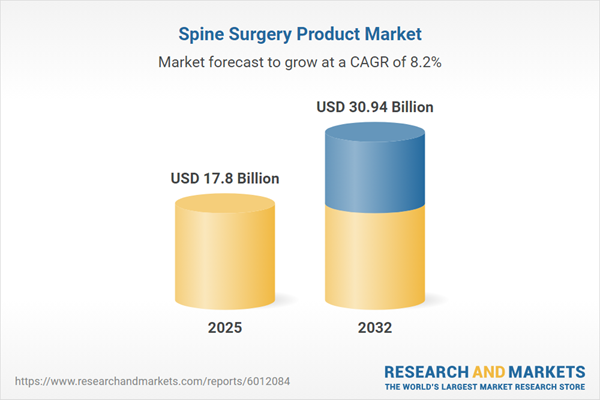Speak directly to the analyst to clarify any post sales queries you may have.
The global spine surgery product market is undergoing significant change, shaped by advancements in technology and evolving compliance requirements. As healthcare leaders adapt to shifting operational landscapes, new strategies are emerging to foster resilience and position organizations for sustainable growth.
Market Snapshot: Spine Surgery Product Market Outlook
Currently valued at USD 16.47 billion, the spine surgery product market is forecast to reach USD 30.94 billion by 2032, with a robust compound annual growth rate (CAGR) of 8.19%. This upward trajectory is propelled by the rapid adoption of digital health methodologies and the continuous integration of next-generation surgical technologies. Senior executives are adapting organizational structures and increasing interdepartmental collaboration to meet the demands of a market where regulations and patient care expectations are in flux. Leaders are also recalibrating market entry and operational models in response to evolving clinical and technological dynamics, ensuring long-term competitiveness.
Scope & Segmentation of the Spine Surgery Product Market
This comprehensive report provides actionable segmentation insights, supporting healthcare executives in identifying areas of opportunity and managing risks across diverse domains:
- Surgery Approach: Evaluate minimally invasive, endoscopic, and conventional open procedures to guide decisions around training, workforce optimization, and resource deployment.
- Product Type: Assess a wide range of devices including allografts, autografts, specialized spinal implants, synthetic biologics, as well as fusion and non-fusion products, enabling strategy development for clinical personalization and procurement.
- Material: Review advanced materials such as titanium and stainless steel, considering durability, cost-efficiency, and compatibility with evolving clinical protocols.
- End User: Analyze the implications for ambulatory surgery centers, private medical practices, and public health organizations, highlighting how demographic trends and infrastructure needs shape adoption.
- Distribution Channel: Examine the merits of direct versus distributor-driven models to align procurement processes and streamline operations in complex networks.
- Geographic Coverage: Understand regional market differences across the Americas, Europe, Middle East and Africa, and Asia-Pacific, focusing on regulatory environments, technological integration, and access strategies to inform both local and international priorities.
- Leading Companies Profiled: Benchmark strategic positioning and performance of industry leaders such as Medtronic plc, DePuy Synthes, Stryker Corporation, Zimmer Biomet Holdings, NuVasive, Globus Medical, Orthofix Medical, Alphatec Holdings, Medacta International, and SeaSpine Holdings.
Key Takeaways for Senior Decision-Makers
- Adoption of less invasive surgical procedures is prompting investments in clinical training and procurement to enhance care delivery models and meet patient demand for better recovery experiences.
- Incorporation of advanced imaging and digital navigation technologies supports greater procedural accuracy, reducing operational variance and enhancing workflow efficiency in surgical environments.
- Expansion in biologic and motion-preservation solutions enables more individualized treatment protocols, fostering stronger clinician and patient engagement while supporting value-based care initiatives.
- Growth in supplier partnerships and the diversification of manufacturing locations allow organizations to navigate supply chain risk and maintain readiness for regulatory or market-related changes.
- Strategic collaboration between device manufacturers and healthcare systems is producing operational efficiencies and encouraging the allocation of resources for value-driven outcomes at an enterprise level.
- Partnerships, mergers, and acquisitions are bringing together complementary technology portfolios, supporting the delivery of integrated solutions in diverse healthcare settings.
Tariff Impact on Supply Chain and Device Adoption
Recent shifts in U.S. tariff policies have led manufacturers to broaden sourcing strategies and boost domestic production. By adopting flexible financial models and enhancing supplier relationships, organizations are better prepared to manage supply chain and trade uncertainties on both a local and international scale.
Methodology & Data Sources
Analysis is built on continuous regulatory tracking, comprehensive clinical trial reviews, and direct input from stakeholders such as surgeons, healthcare administrators, payers, and supply chain experts. This triangulated approach ensures senior leaders receive balanced, actionable insights aligned with current and emerging spine surgery product market trends.
Why This Report Matters: Actionable Insights for Leadership
- Empowers executive teams to align investment and talent strategies with evolving technology and new standards of care, supporting organizational performance and clinical excellence.
- Delivers focused competitive benchmarking and enhanced supply chain intelligence, enabling health systems to react quickly to regulatory and market developments.
- Supports identification of strategic alliances and technology integration opportunities, driving sustainable business growth and the successful delivery of care across complex healthcare environments.
Conclusion
Healthcare organizations that proactively adjust strategies, strengthen partnerships, and incorporate new technologies will be positioned to achieve greater stability and sustained progress within the evolving spine surgery product landscape.
Additional Product Information:
- Purchase of this report includes 1 year online access with quarterly updates.
- This report can be updated on request. Please contact our Customer Experience team using the Ask a Question widget on our website.
Table of Contents
3. Executive Summary
4. Market Overview
7. Cumulative Impact of Artificial Intelligence 2025
Companies Mentioned
The companies profiled in this Spine Surgery Product market report include:- Medtronic plc
- DePuy Synthes, Inc.
- Stryker Corporation
- Zimmer Biomet Holdings, Inc.
- NuVasive, Inc.
- Globus Medical, Inc.
- Orthofix Medical Inc.
- Alphatec Holdings, Inc.
- Medacta International SA
- SeaSpine Holdings Corporation
Table Information
| Report Attribute | Details |
|---|---|
| No. of Pages | 182 |
| Published | October 2025 |
| Forecast Period | 2025 - 2032 |
| Estimated Market Value ( USD | $ 17.8 Billion |
| Forecasted Market Value ( USD | $ 30.94 Billion |
| Compound Annual Growth Rate | 8.1% |
| Regions Covered | Global |
| No. of Companies Mentioned | 11 |









